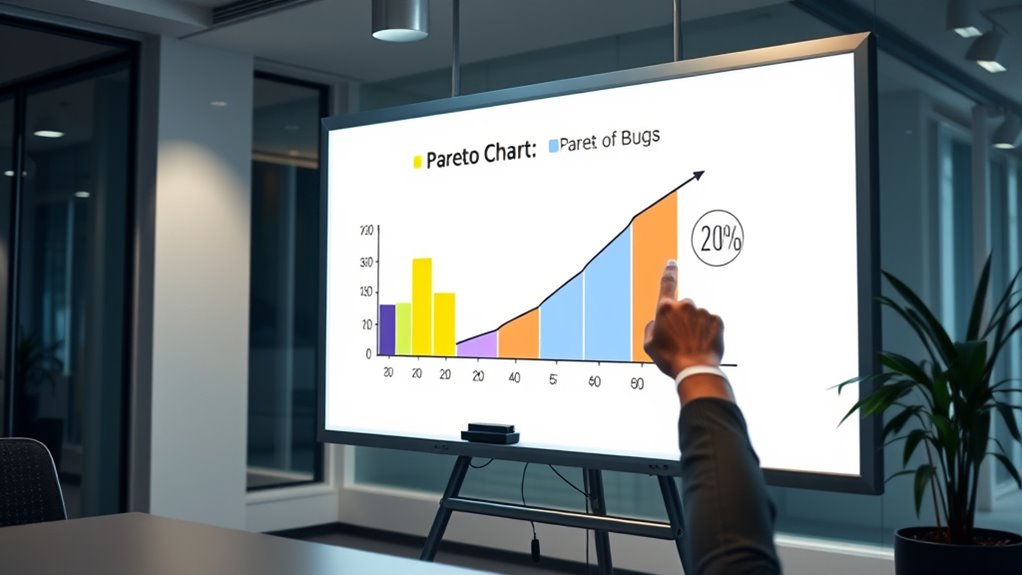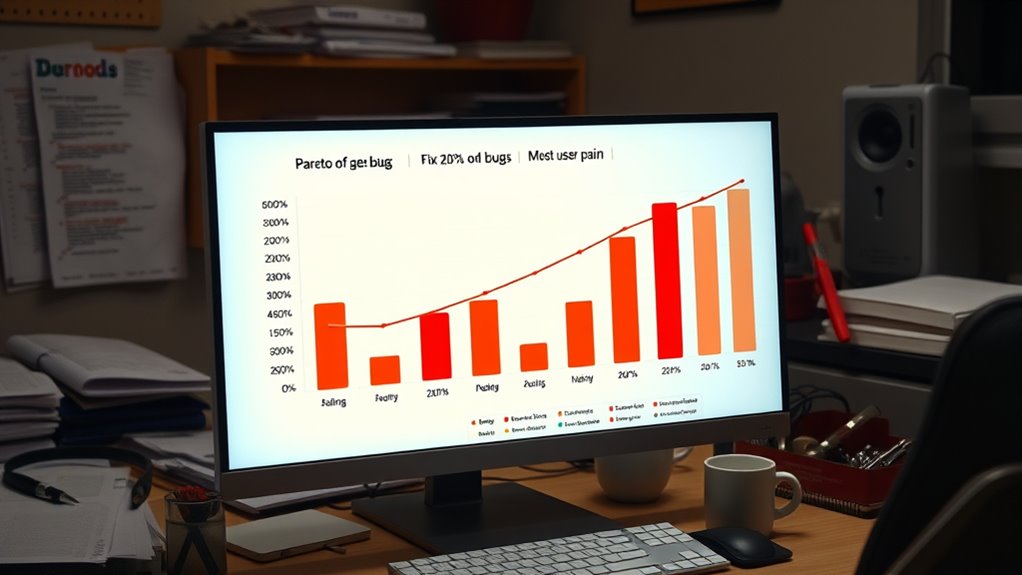By applying Pareto Analysis, you can identify the top 20% of bugs that cause 80% of system pain. Focusing your efforts on fixing these critical issues means you’ll substantially improve user experience, reduce support tickets, and streamline development. This targeted approach saves time and resources while maximizing impact. To learn how to implement this strategy effectively and enhance your software quality, keep exploring the key steps involved.
Key Takeaways
- Pareto analysis identifies the top 20% of bugs causing 80% of user issues or system failures.
- Prioritizing fixing high-impact bugs maximizes resource efficiency and significantly improves software quality.
- Visual tools like charts help pinpoint the most critical defects for targeted resolution efforts.
- Regularly reviewing defect data refines bug prioritization, ensuring continuous improvement.
- Addressing the most influential bugs first enhances user satisfaction and reduces support workload.

Have you ever wondered why a small number of problems or causes often lead to the majority of your results or issues? That’s the core idea behind Pareto analysis. When it comes to bug prioritization and defect management, this principle helps you focus on the few bugs that are causing the most considerable problems. Instead of spreading your efforts thin across every tiny glitch, you identify and fix the critical 20% of bugs that create 80% of the pain. This approach saves time, reduces frustration, and boosts your software’s overall quality faster.
Focusing on the critical 20% of bugs that cause 80% of the problems boosts software quality and efficiency.
In software development, not all bugs are equal. Some might be minor annoyances, while others cause system crashes, data loss, or security vulnerabilities. By applying Pareto analysis, you analyze defect data to spot the most common or severe issues. This isn’t about ignoring the smaller bugs but recognizing which ones have the biggest impact. Proper bug prioritization means you assign urgency and resources to those high-impact defects first. This targeted focus helps your team avoid wasting effort on trivial issues that don’t considerably affect end-users or system stability.
Effective defect management hinges on this principle. When you understand that fixing a handful of key bugs can dramatically improve user experience and reduce support tickets, your strategic decisions become clearer. Instead of chasing every bug report, you leverage data to determine which problems, if resolved, will yield the greatest benefits. This not only accelerates your development cycle but also improves customer satisfaction because you’re addressing the issues that matter most.
Implementing Pareto analysis in bug tracking involves gathering data from your testing and support teams. Use tools that can categorize bugs by frequency, severity, or impact, then visualize this data with charts or graphs. Once you see that roughly 20% of bugs are responsible for most of the issues, you can prioritize fixing those first. This method creates a cycle of continuous improvement, where you regularly revisit your defect data, refine your bug prioritization, and streamline your defect management process.
Frequently Asked Questions
How Do I Identify the Critical 20% Bugs Efficiently?
To identify the critical 20% bugs efficiently, use prioritization techniques that focus on bug severity and impact. Review bug reports to spot issues causing the most significant user pain or system failure. Filter bugs by severity levels, and prioritize those with high severity and frequency. This approach helps you target the most impactful bugs first, ensuring your efforts yield maximum results and reduce overall pain quickly.
Can Pareto Analysis Be Applied to Non-Bug-Related Issues?
You can definitely apply Pareto analysis to non-bug issues, especially when aiming for process improvement and resource allocation. By identifying the 20% of causes that lead to 80% of problems, you focus your efforts effectively. This approach helps you prioritize actions, optimize resources, and achieve significant results quickly, whether addressing customer complaints, operational inefficiencies, or other challenges in your organization.
What Tools Best Support Pareto Analysis in Software Testing?
Imagine uncovering hidden patterns in your testing process—you’re likely thinking of tools that aid bug prioritization. Data visualization tools like Tableau, Power BI, or Excel charts excel at this, helping you identify the most impactful bugs. These tools enable quick analysis and clear communication, making bug prioritization easier. By visualizing defect data, you focus on fixing the few critical issues that reduce most pain, streamlining your testing efforts.
How Often Should Pareto Analysis Be Reviewed for Accuracy?
You should review your bug prioritization and data visualization regularly to keep your analysis accurate. Typically, a monthly review works well, but if your project moves fast or bugs change frequently, consider weekly check-ins. This ensures you’re addressing the most critical issues and accurately identifying the 20% of bugs causing 80% of pain. Consistent reviews help maintain effective bug management and improve overall software quality.
Are There Limitations to Using Pareto in Complex Systems?
Isn’t it tempting to believe Pareto analysis can solve all? In complex systems, limitations emerge because data reliability can falter, and system complexity often blurs the true cause-effect relationships. You might find that prioritizing 20% of bugs doesn’t always address the root issues. While powerful, Pareto’s effectiveness diminishes when data isn’t accurate or when system interactions are too intricate to simplify into a few key factors.
Conclusion
By fixing just 20% of your bugs, you’ll crush 80% of your pain—it’s like wielding a superpower! Imagine turning chaos into smooth sailing overnight, all from a tiny handful of issues. Don’t waste time chasing every bug; focus on that small elite, and watch your problems vanish faster than you ever thought possible. Embrace Pareto analysis, and reveal the secret to instant relief—your stress-free, flawless system awaits!









